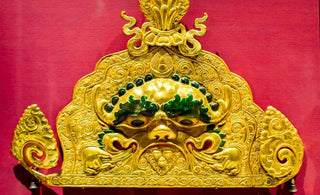
In the realm of Tibetan Buddha statues, a captivating evolution unfolds as artisans skillfully weave together threads of tradition and contemporary expression. This fusion of styles creates a tapestry where ancient spiritual narratives intertwine with the sensibilities of the present, giving rise to statues that resonate with a diverse and evolving audience.
At the heart of this fusion lies a delicate dance between traditional aesthetics and modern influences. Tibetan Buddha statues, rooted in centuries-old artistic traditions, have become canvases for contemporary artists to explore new expressions, breathing fresh life into timeless figures. The keyword "traditional" evokes a rich tapestry of artistic conventions, iconography, and spiritual symbolism that have endured through generations. The serene countenance, the symbolic mudras, and the intricate details resonate with the spiritual heritage of Tibetan Buddhism.
Contrastingly, the keyword "contemporary" signals a departure from strict adherence to traditional forms. Modern interpretations of Tibetan Buddha statues introduce innovative elements, pushing the boundaries of artistic expression.
One notable example of this dynamic fusion is evident in the contemporary rendition of Green Tara, a revered bodhisattva associated with compassion and enlightened activity. Green Tara traditionally embodies timeless qualities such as grace, compassion, and a nurturing presence. In a modern interpretation, artists retain these essential elements while introducing innovative nuances that capture the zeitgeist of our era.
The traditional aspects, such as Green Tara's compassionate gaze, the flowing robes, and the classic lotus seat, serve as foundational elements, anchoring the statue in its cultural and spiritual roots. However, the contemporary twist emerges in the dynamic pose, which might include a subtle inclination of the head or a modernized rendering of the lotus seat. The fusion of traditional and contemporary aesthetics allows the timeless figure of Green Tara to transcend temporal boundaries, making a profound connection with a diverse audience.
Materials and techniques also play a crucial role in modern interpretations. The choice of medium, whether intricately carved wood or meticulously cast metal, may reflect a conscious decision to blend traditional craftsmanship with contemporary artistic expression. The lotus, a symbol deeply entrenched in Buddhist narratives, could be reimagined with a contemporary aesthetic, blending traditional symbolism with innovative design.
The gilding process, often associated with traditional Tibetan statues, takes on a modern flair in these interpretations. While gilding traditionally serves as a symbol of purity and enlightenment, contemporary artists may apply this technique with a nuanced touch, creating a luminosity that captures both the divine radiance associated with the Buddha and the vibrancy of contemporary sensibilities.
This dynamic fusion of tradition and contemporary innovation extends beyond the physical form of the statues. Modern interpretations often delve into the symbolism and narratives associated with Buddhist philosophy, reinterpreting traditional stories to resonate with the challenges and aspirations of the present day. The reinterpretation of traditional narratives not only breathes new life into the statues but also invites viewers to engage with age-old wisdom through a contemporary lens.
Artists, drawing inspiration from both historical contexts and contemporary realities, infuse these sacred figures with dynamic vitality that speaks to the evolving nature of spirituality and human experience.
Consider a contemporary rendition of Green Tara, a bodhisattva associated with compassion and enlightened activity. The traditional aspects—her compassionate gaze, the flowing robes, and the lotus seat—are retained, anchoring the statue in its cultural and spiritual roots. However, the contemporary twist emerges in the dynamic pose, perhaps a subtle inclination of the head or a modern rendering of the lotus seat. This fusion allows the timeless figure of Green Tara to transcend temporal boundaries, making a profound connection with a diverse audience.
Intricately carved wood or meticulously cast metal may serve as the medium for this fusion. The lotus, a symbol deeply entrenched in Buddhist narratives, could be reimagined with a contemporary aesthetic, blending traditional symbolism with innovative design. The gilding process, often associated with traditional Tibetan statues, may be applied with a modern flair, creating a luminosity that captures both divine radiance and contemporary sensibilities.
The melding of traditional and contemporary elements in Tibetan Buddha statues not only broadens the scope of artistic expression but also makes these sacred figures more accessible to a diverse audience. While traditional statues predominantly depicted male figures, contemporary interpretations increasingly include representations of female Buddhas and diverse forms of enlightened beings. This inclusive approach aligns with contemporary values of diversity and gender equality, offering a more representative reflection of the multifaceted nature of enlightenment.
Conclusion
In conclusion, the fusion of styles in Tibetan Buddha statues serves as a testament to the dynamic nature of artistic evolution. This harmonious interplay between tradition and contemporaneity breathes new life into sacred figures, ensuring their relevance in an ever-changing world. As artists continue to explore the nexus between the timeless and the modern, Tibetan Buddha statues stand as bridges between cultural heritage and the evolving expressions of spirituality, inviting all to witness the rich tapestry of tradition seamlessly interwoven with the vibrant hues of contemporary creativity.























